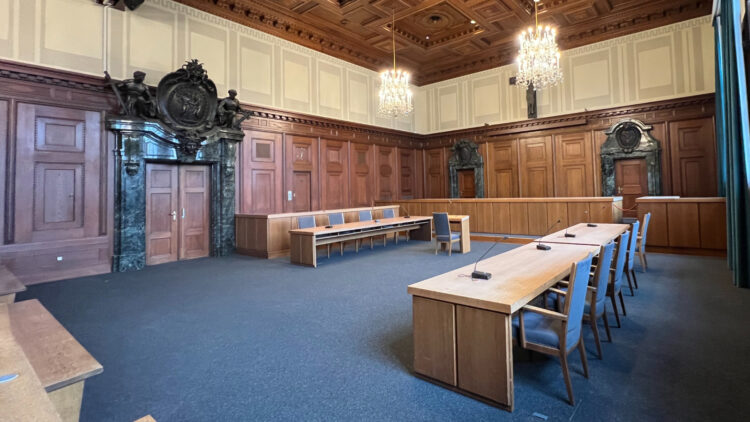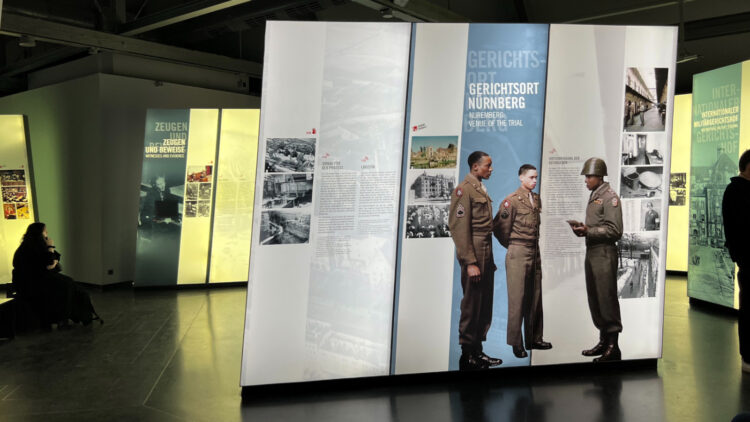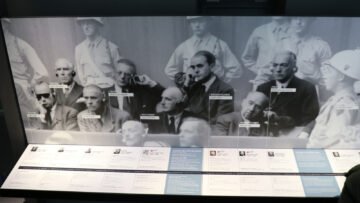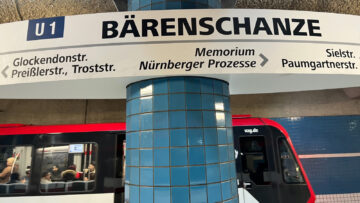Visit the Nuremberg Trials Memorial (Memorium Nürnberger Prozesse) to see Courtroom 600 and an exhibition on the International Military Tribunal held at the end of WWII in Germany.

The Nuremberg Trials Memorial (Memorium Nürnberger Prozesse) allows visitors to see the original Courtroom 600 where the International Military Tribunal was held after the Second World War. Here, senior National Socialist leaders had to face justice in an international criminal court of law for crimes against humanity. The memorial’s permanent exhibition provides a wealth of information, photos, and contemporary video material on the major war criminals’ trial, subsequent trials, and the development of international criminal courts. However, the primary highlight is visiting the genuine historical location of Courtroom 600. A visit by children under 14 is not recommended. Admission is covered by the Nürnberg City Card.
Visit the Nuremberg Trials Memorial in Nürnberg, Germany
The Nuremberg Trials Memorial (Memorium Nürnberger Prozesse) is a permanent exhibition in the Palace of Justice in Nürnberg, Germany, where the International Military Tribunal tried senior members of the Nazi regime at the conclusion of the Second World War.
Visitors to the memorial may enter Courtroom 600, where the main trial took place, before proceeding to the exhibition on a higher floor. This museum area is like a documentation center with a wealth of information, photographs, and video material on display.
The main focus of the permanent exhibition is the major war criminals’ trial in Nuremberg, including the background to the war and the war crimes, the people involved, and the verdicts. Further sections cover further trials of less senior people, how the Germans deal with the Nazi past, and the development of international criminal law from Nuremberg to the International Criminal Court in The Hague. Temporary exhibitions (usually free) on related themes are often held in an adjacent building (Cube 600).
Unlike hardly any other place, Nuremberg (Nürnberg) stands for the application of law both as a means of suppression and as an instrument of the rule of law. As the place where the “Nuremberg (Racial) Laws” were proclaimed in 1935, Nuremberg has remained firmly linked to this creation of a pseudo-legal basis for robbing minorities of their rights but Nuremberg is also associated with the restitution of the principles of the rule of law by the Allied Powers after 1945.
The Nuremberg Trials Memorial (Memorium Nürnberger Prozesse) is dedicated to this new start, to the restitution of the rule of law in Germany, and to the further development of International Criminal Law.
The Nuremberg Trials — A Brief History
The Nuremberg Trials (Nürnberger Prozesse) were held at the end of the Second World War following a decision by the four Allied powers (USA, Britain, France, and the Soviet Union) to hold the senior German leadership accountable in a court of law for the crimes committed by the Nazi regime.
From 20 November 1945 to 1 October 1946, the International Military Tribunal’s (IMT) trial of the main war criminals was held in Court Room 600 at the Nuremberg Palace of Justice. Twelve follow-up trials were also held here by the American forces from 1946 to 1949.
The opening session of the IMT was in Berlin on 18 October 1945. The four main prosecutors presented the indictments against 24 Nazi main war criminals, as well as against six “criminal organizations”: the Reich cabinet, the leadership corps of the NSDAP, the Schutzstaffel (SS), and Sicherheitsdienst (SD), the Sturmabteilung (SA), the General Staff and High Command of the Armed Forces (OKW), as well as the Secret State Police (Gestapo).
The IMT then adjourned the proceedings until 20 November 1945, when the trial continued in Nuremberg, which was centrally located in Bavaria inside the American occupation zone.
During the 218 trial days in Nuremberg, 236 witnesses were heard in person, about 200,000 affidavits were used as evidence, and 5,330 documents were presented, including comprehensive film evidence. The court hearing ended on 31 August 1946, and on 1 October 1946, the sentences were proclaimed. Twelve defendants were sentenced to death by hanging, seven to prison, and three were acquitted.
The death sentences were executed on 16 October 1946. (Hermann Göring committed suicide a few hours earlier.) The seven defendants sentenced to prison were mostly incarcerated in Berlin-Spandau. (Rudolf Heß, the last remaining prisoner, committed suicide at the age of 93 in 1987.)
The Americans used the Palace of Justice for further trials and Court Room 600 was only returned to German jurisdiction in 1961. It was used as a regular high courtroom (Schwurgerichtssaal) until 2020.
See Courtroom 600 in Nuremberg

Seeing Courtroom 600 (Schwurgerichtssaal 600) is the main reason to visit the Nuremberg Trials Memorial in Nürnberg. Most visitors start their visit here.
A few times per day, a media installation “Zeitreise Saal 600 | Courtroom 600: Time Travel” brings together original film footage of the trials with a digital reconstruction of the site. In 15 minutes, visitors get a very good overview of the events 80 years ago. If the media installation is not active, consider the excellent audioguide (freely downloadable from the museum website) for a description of the courtroom, as well as translations of further exhibition stations that are not always translated into English.
The first impression many visitors get is how small Courtroom 600 is. During the trial, one of the walls was temporarily removed to provide space for the press and other visitors. Comparing historic photos, confirmed that the courtroom was packed tightly and that many of the wall decorations survived unaltered to the present including the wall clock behind the defendants.
The decorations on the door frame to the left are also the same as in 1945. At the center is the original sin or fall from grace with Eve offering Adam an apple while the snake looks on. This shield is flanked by two young men: the man on the left represents Germanic law and on the right Roman law — the two cornerstones of German law. Just above the door is a carving of the head of Medusa.
Courtroom 600 was in regular use until 2020 but is now open to visitors as part of the memorial. If closed for rare special events, visitors may still see into the courtroom from windows in the exhibition area.
Permanent Museum Exhibition of the Nuremberg Trials Memorial

The permanent exhibition of the Nuremberg Trial Memorial is mostly a documentation center with information panels, historic photos, and historic video material. Many information panels are in German only but the free audio guide provides full translations.
While Courtroom 600 is the authentic historical location, very few items from the trial or period itself are on display. (This is often deliberate in Germany to prevent memorials from being used overtly as shrines by far-right organizations.) The few original items on display include the bench (docket) for the accused, a crate used for transporting documents, and the electric control cabinet that was used to regulate the power supply in the courtroom.
The largest and most interesting part of the exhibition is on the International Military Tribunal in which the major war criminals were tried. The comprehensive coverage includes the background to the war, crimes, and the decision to bring the perpetrators to international justice, short biographies of the defendants and litigants, the way the press and media covered the trial, the conduct of the trial, and the verdicts.
A further section covers the subsequent trials, where the American forces tried many further high-ranking representatives of the military, administration, medical profession, legal system, industry, and politics. It also examines how Germans deal with the Nazi past — not only in the immediate aftermath of the war but also in subsequent decades, and the present.
The third part of the exhibition is devoted to the legacy of the Nuremberg Trials, which led to the establishment of the International Criminal Court in Den Haag. It also has displays on armed conflicts since the end of the Second World War and contemporary witness accounts.
The Trial Archive of the International Military Tribunal is kept in the Peace Palace in The Hague while the documents from the Subsequent Nuremberg Trials are in the National Archives of the United States of America in College Park, MD. A wealth of information is available online.
Nuremberg Trials Memorial Visitor’s Information

Opening Hours to Visit the Nuremberg Trials Memorial
The Nuremberg Trial Memorial is closed on Tuesdays but otherwise open daily from 10:00 to 18:00, opening already at 9:00 on weekday mornings from April to October.
Check opening hours for public holidays — the memorial does not always follow the standard German pattern. It is for example open all day on December 31 but closed on October 3.
Since 2020, Court Room 600 is no longer used as a regular courtroom and is thus almost always open to visitors. (Previously, it was often only accessible on weekends.) If Room 600 is closed for special events, visitors may still see the room through windows in the permanent exhibition area. The occasional closure of Courtroom 600 is advised on the museum’s website.
Tickets to Visit the Nuremberg Trials Memorial
Ticket prices to visit the Nuremberg Trial Memorial are €7.50 for adults and €2.50 for children aged 4 to 18 years. (Add €3 to see any further Nuremberg municipal museum on the same day.) Tickets are sold only at the memorial and reservations are only possible (and needed) for groups larger than ten. Admission with the Nürnberg City Card is free.
Families qualify for significant discounts. Although there is no age restriction, the memorial recommends a minimum age of 14 years, especially if children had not previously learned about the disturbing crimes committed during the period of National Socialism.
Nürnberg City Card: Save on Sightseeing in Nuremberg
Two discount deals are worth considering to save on sightseeing when visiting Nuremberg (Nürnberg):

A day ticket valid for admission to all Nuremberg city municipal museums is €10.50 and gives admission to the Albrecht-Dürer-Haus, Museum Tucherschloss und Hirsvogelsaal, Stadtmuseum Fembo-Haus, Spielzeugmuseum (Toys), Museum Industriekultur, Nuremberg Trial Memorial, and the Dokumentationszentrum Reichsparteigelände. It is available from all participating museums.
The Nürnberg City Card is around €33 and covers all public transportation in Nuremberg and Fürth for 48 hours. It gives free admission to the Imperial Castle Nuremberg (Kaiserburg), Deutsches Museum Nuremberg, Germanisches Nationalmuseum, Albrecht Dürer House, Neues Museum, Toy Museum, Documentation Center Nazi Party Rally Grounds Interim Exhibit (main exhibition closed until 2025), Memorium Nuremberg Trials, DB Museum (German Railways Museum), Museum for Communication, Museum of Industrial Culture with the School Museum, City Museum at Fembo House Permanent Exhibit: A Crown – Power – History, Museum Tucher Mansion, Bavarian Bible Museum, Museum of Natural History, towerofthesenses, Kunsthalle Nuremberg, Kunstvilla Nuremberg, Kunsthaus Nuremberg, Museum Executioner’s House, Zoo Nuremberg, Children’s Museum, Red Cross Museum, Motor Museum Merk, Faber-Castell Stately Home with the Museum “Alte Mine”, Bratwurst Museum, Jewish Museum Franconia, Fürth, City Museum Fürth, and Ludwig Erhard Center Fürth. It also gives savings on guided tours and further events.
Transportation to Visit the Nuremberg Trials Memorial
The Nuremberg Trials Memorial (Memorium Nürnberger Prozesse), Bärenschanzstraße 72, 90429 Nürnberg is located inside the Palace of Justice (Justizpalast Nürnberg) just outside the city center. It is easily reached on public transportation. The closest U-Bahn train station is Nürnberg Bärenschanze) — 5 stops / 7 minutes from the Hauptbahnhof (Main Station). Metro line U1 runs up to ten times per hour and stops amongst others in the old town area at the Lorenzkirche and Weißer Turm U-Bahn stations.
It is a five-minute walk from the Bärenschanze station to the Memorial — signposting is clear but it is basically a long block along Fürther Straße and turn right.
More on Traveling to Nürnberg:

- Buy a Nürnberg City Card to save on sightseeing and transportation.
- Top Sights to See in Nuremberg:
- Visit the Nuremberg Trials Memorial (Courtroom 600)
- Reichsparteitagsgelände (Nazi Party Rally Grounds)
- Visit the Germanisches Nationalmuseum — the largest cultural history museum in Germany.
- Visit the Kaiserburg — Imperial Castle in Nuremberg
- Visit the Albrecht-Dürer-Haus Museum where the artist lived and worked for two decades.
- Visit the DB German Railways Museum
- Visit the Nuremberg Christmas Market (Nürnberger Christkindlesmarkt)
- Transportation to Nuremberg in Bavaria
- Traveling by Train to Nuremberg – German Railways Timetables to Nuremberg
- Book Flights on Lufthansa, KLM, Eurowings or Air France.
- Cheap Flights to Nuremberg Airport (NUE)
- Transportation to Nuremberg Airport (NUE)
- Transportation from Munich Airport (MUC) to Nuremberg
- Nuremberg hotels are generally less pricey than those in Frankfurt or Munich.
- Adidas Factory Outlet Stores — half an hour north of Nuremberg but a very popular stop en route to Bamberg.
- Suntransfers give online quotations without requiring flight and personal details.
















